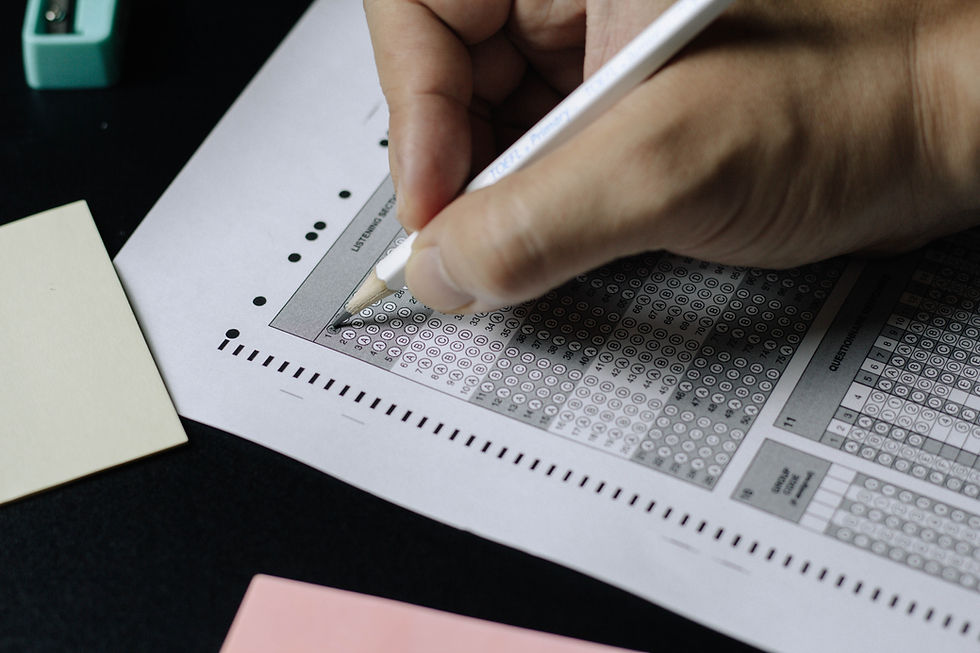Tips to Help Students Prepare for the PSAT
- Dave Bell

- Feb 27, 2023
- 4 min read
Updated: Feb 5, 2024

The Preliminary Scholastic Aptitude Test, better known as the PSAT, is a standardized test given mostly to high school juniors. Taking the PSAT serves as good preparation for the SAT because the two tests are very similar. Students who score exceptionally well on the PSAT can achieve National Merit Semifinalist or Commended status and may also be eligible for college scholarships.
The PSAT is a very predictable test, so by learning techniques and strategies, a student can improve his or her score. As you begin to prepare for the PSAT, we recommend that you set the bar at a high, but realistic, level. After setting your goal score, it’s important to make a plan and timeline for achieving your goal score. This plan should include scoring practice tests and identifying areas for improvement. In other words, you should learn from your mistakes.
For example, if you struggle with plane geometry problems, give yourself a refresher on that topic. Or, if you are not strong on word problems, dedicate extra time to figuring out why they are causing you problems.
The PSAT math section is mostly multiple choice, meaning the correct answer is there waiting to be found! It also means that even when the correct answer doesn’t immediately jump out, you can use process of elimination to “back into” the correct answer. Often, one or two of the answers can be eliminated using common sense.
Here’s an example taken from a released, official PSAT:
1. A babysitter earns $8 an hour for babysitting 2 children and an additional $3 tip when both children are put to bed on time. If the babysitter gets the children to bed on time, what expression could be used to determine how much the babysitter earned?
A. 8x + 3, where x is the number of hours
B. 3x + 8, where x is the number of hours
C. x(8 + 2) + 3, where x is the number of children
D. 3x + (8 + 2), where x is the number of children
The problem indicates that the tip ($3) is a fixed amount if the children were put to bed on time – which you are told they were. So the number 3 should appear by itself in the correct answer. Answer choices B and D both have 3x rather than 3, so they can be eliminated. And since the babysitter earns $8 an hour, the expression also should contain an 8x, where x represents the number of hours. Answer choice A is correct.
Here is another example from the same PSAT test:

2. Triangle ABC (above) is isosceles, with AB = AC and BC = 48. The ratio of DE to DF is 5:7. What is the length of DC?
A. 12
B. 20
C. 24
D. 28
This problem can be solved by figuring out that since the large triangle is isosceles, the two smaller triangles are similar, making the ratio of BD to DC also 5:7 and making DC more than half of 48. The easier shortcut way to solve the problem is to look at the drawing and see (notwithstanding the "Figure not drawn to scale" language) that BD is shorter than DC. Therefore, C must be more than half of 48, and only answer choice D works.
If you had unlimited time, finding shortcuts would be unnecessary. However, since the PSAT is a timed test, and you only have about one minute per question on the math section, you need to find ways to simplify the path to the correct answer.
Here is another tip to help you prepare. The first page of each Math section of the PSAT includes a number of equations and other helpful information. Many students skip over this page. However, it can be helpful if you can’t remember information like the area of a triangle or the circumference of a circle. Better yet, instead of having to refer to this page, just memorize this information.
One final, common-sense tip. It is not unusual for students, especially when they are starting to prepare for the PSAT, to try to work out math problems in their head. But why do that when the blank space in the test booklet is there for you to use as scratch paper! Use this space to draw a diagram, write out your solution to a problem, or do a calculation. Not only is working out the answer on paper less likely to lead to careless errors, it also sometimes helps you get to the solution faster.
Because the PSAT is such a predictable test, you can expect to see the same kinds of math problems over and over again. The PDF linked below includes 40 of the most common formulas, topics, and equations that are likely to appear on the PSAT. We encourage you to review the list carefully and identify topics that you believe merit closer review.
Dave Bell, who organizes ACT and SAT workshops for area high schools and not-for-profit organizations, can be reached for answers to your questions at Dave@thewholekid.com.



